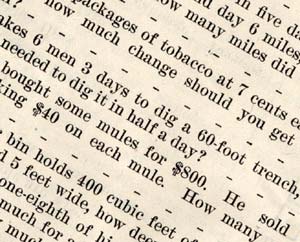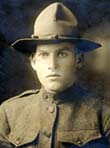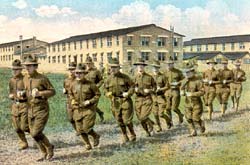The Testing Begins
 Inductees were given tests to determine their skills. Put yourself to the test. Nine of the ten tests include instructions. Test 1 does not. If you can figure it out, you deserve extra credit. Test 2 requires a partner. Answers are not provided.
View examination (PDF).
Inductees were given tests to determine their skills. Put yourself to the test. Nine of the ten tests include instructions. Test 1 does not. If you can figure it out, you deserve extra credit. Test 2 requires a partner. Answers are not provided.
View examination (PDF).
Once a person was inducted into the Army, testing inevitably followed. Officials wanted to determine how to effectively use each soldier's knowledge, skills, and abilities. One examination included 10 test sections covering shapes, number sequences, word order, arithmetic story problems, current events and general knowledge, opposite words, common sense, number patterns, logic, and numerical sizes. Many of the test questions were appropriate for the war service. Examples:
- A certain division contains 3,000 artillery, 15,000 infantry, and 1,000 cavalry. If each branch is expanded proportionately until there are in all 20,900 men, how many will be added to the artillery? (Answer: 300)
- A first class batter now averages around .300, .900, .600, .100 (Answer: In baseball good batters averaged around .300 or three hits in every 10 at bats.)
- bushes trees roots have and their air the in (straighten out this sentence and tell if true or false. Answer: Trees and bushes have their roots in the air - False)
- Innuendo - insinuation: Are these words the same or opposite? (Answer: Same).
- Why is a telephone more useful than a telegraph? Because: a.) it gets a quicker answer; b.) it uses more miles of wire; c.) it is a more recent invention; d.) telephone wires can be put under ground. (Answer: a.) it gets a quicker answer.)
The Stateside Daily Routine
 Carl Jones trained in Vancouver. (OSA)
Carl Jones trained in Vancouver. (OSA)
Carl W. Jones of Brookings volunteered for the Army soon after the U.S. declared war in April 1917. He was assigned to Company B of the 4th U.S. Engineers based just across the Columbia River at the Vancouver Barracks in Washington State. Near the end of a summer of training, Jones described a typical day:
5:45 AM - Get up and dress.
6:00 AM - Reveille [or roll call]. Dismissed. Sweep and clean around cot, wash up, and ready for mess.
ca.
6:30 AM - Mess [breakfast]. Afterwards police [clean up] around quarters.
 Morning exercise was common in training camps. (Image: freepages.military.rootsweb.com)
Morning exercise was common in training camps. (Image: freepages.military.rootsweb.com)
7:00 AM - Drill call. Some mornings have 30 minutes of exercises.
8:00-11:30 AM and 1-3 PM - Engineering school and drill, building trenches, barbed wire entanglements, obstacles, and all types of bridges. Also learn map reproducing, scouting, wig wag, and semaphore signals.
3 PM - Infantry drill. Certain days have practice hikes with increasing mileage and weight.
4 PM - Shower. Change clothes.
5 PM - Mess [dinner].
5:20 PM - Retreat [evening roll call]. After roll is called and all orders are repeated by the first sergeant, salute flag while "Star Spangled Banner" or "Colors" is played.
ca.
6 PM - Dismissed.
The Larger Routine
Jones went on to describe other routines at his Vancouver Barracks in a letter:
Notes
(Oregon Defense Council Records, Publications and Ephemera, Box 8, Folder 3; Personal Military Service Records, World War I, Box 2, Curry County, School District No. 11)